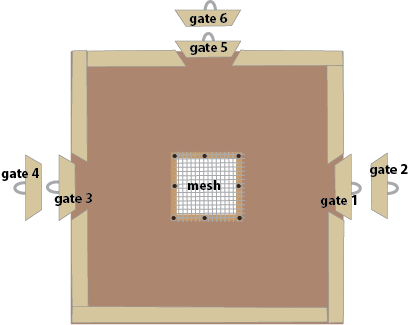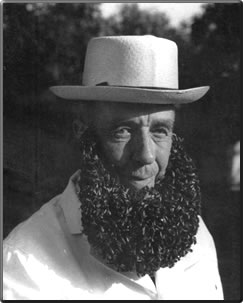L. E. Snelgrove
Swarming
In the first paragraph of his book published in 1934
Swarming: Its Control and Prevention ; L. E. Snelgrove states:
'The problem of controlling and preventing the swarming of bees has exercised men's minds ever since bees were first kept in hives. The invention of movable combs, which greatly increased the possibility of control, in some respects intensified the problem. Most beekeepers of today have little difficulty in managing bees during ten months of the year but when the swarming months come and they are anticipating a good yield of honey as a reward for their labours and care, they are dismayed and often reduced to a state of despair by the frequent disappearance of swarms from their best stocks. Indeed, apart from bee diseases, the difficulty of swarm control still remains the greatest obstacle to successful beekeeping'.
What was true then is still true today. In his book Snelgrove describes two methods of swarm control which he calls
Method I and Method II in which he describes his split board and its use
- the Snelgrove Board.
'The problem of controlling and preventing the swarming of bees has exercised men's minds ever since bees were first kept in hives. The invention of movable combs, which greatly increased the possibility of control, in some respects intensified the problem. Most beekeepers of today have little difficulty in managing bees during ten months of the year but when the swarming months come and they are anticipating a good yield of honey as a reward for their labours and care, they are dismayed and often reduced to a state of despair by the frequent disappearance of swarms from their best stocks. Indeed, apart from bee diseases, the difficulty of swarm control still remains the greatest obstacle to successful beekeeping'.
What was true then is still true today. In his book Snelgrove describes two methods of swarm control which he calls
Method I and Method II in which he describes his split board and its use
- the Snelgrove Board.

The Snelgrove Board
consist of a sheet of plywood with the same dimensions as the brood box. Around its edge and on both side are nailed and glued battens (about 1 " x ⅜" / 25mm x 10mm). On three sides gates are cut (about 4" / 100mm long) on the centre of the battens above and below the board. A central hole (4" x 4" / 100mm x 100mm) is cut in the centre of the board and covered with a mesh.
See this link for details of the board's construction.
The three pairs of gates labelled 1&2; 3&4; 5&6 are manipulated in sequence as described in the text.
The mesh screen lets warm air enter the top box from below, and allows the bees in the two boxes to have contact with one another.
I prefer to have the gates loose with a staple attached (as shown in the diagram) so that they can be inserted or withdraw as wanted.
consist of a sheet of plywood with the same dimensions as the brood box. Around its edge and on both side are nailed and glued battens (about 1 " x ⅜" / 25mm x 10mm). On three sides gates are cut (about 4" / 100mm long) on the centre of the battens above and below the board. A central hole (4" x 4" / 100mm x 100mm) is cut in the centre of the board and covered with a mesh.
See this link for details of the board's construction.
The three pairs of gates labelled 1&2; 3&4; 5&6 are manipulated in sequence as described in the text.
The mesh screen lets warm air enter the top box from below, and allows the bees in the two boxes to have contact with one another.
I prefer to have the gates loose with a staple attached (as shown in the diagram) so that they can be inserted or withdraw as wanted.
Swarm Composition
Essentially the colony is made up of 3 parts: i) the queen, ii) the brood and house bees, and iii) the foraging bees.
Effective swarm control then entails the separation of one of these parts from the other two.
Before swarm control methods are described, it might be instructive to consider the constitution of a swarm, compared to that of the colony before the swarm, and that of an artificial swarm. The pie charts below show only estimated and hence approximate percentages of the brood, house bees, and foragers in respectively a 'normal' colony, a swarm, and an artificial swarm. However, the differences play a very important part in understanding the behaviour of the bees when any form of swarm control is performed.
Essentially the colony is made up of 3 parts: i) the queen, ii) the brood and house bees, and iii) the foraging bees.
Effective swarm control then entails the separation of one of these parts from the other two.
Before swarm control methods are described, it might be instructive to consider the constitution of a swarm, compared to that of the colony before the swarm, and that of an artificial swarm. The pie charts below show only estimated and hence approximate percentages of the brood, house bees, and foragers in respectively a 'normal' colony, a swarm, and an artificial swarm. However, the differences play a very important part in understanding the behaviour of the bees when any form of swarm control is performed.
Click for a pdf copy of Snelgrove's Book
Swarming: Its Control and Prevention
Swarming: Its Control and Prevention

The Swarm's
objective is to form a new colony ensuring the survival of the bees. To this end about 75% of the swarm is composed of young bees; those that can draw wax and feed the new grubs. Some foragers complete the swarm bringing in essential supplies to feed the new grubs.
objective is to form a new colony ensuring the survival of the bees. To this end about 75% of the swarm is composed of young bees; those that can draw wax and feed the new grubs. Some foragers complete the swarm bringing in essential supplies to feed the new grubs.
Normal colony
Towards the end of May and the beginning of June i.e. the swarming season, the colony forms a sort of an equilibrium between the amount of brood, the house bees, and the foragers. Considering that 3 weeks are needed for the brood to emerge, the house bees spend a further 3 weeks on hive duties, before the bees become foragers with a life span of about 6 weeks.
Towards the end of May and the beginning of June i.e. the swarming season, the colony forms a sort of an equilibrium between the amount of brood, the house bees, and the foragers. Considering that 3 weeks are needed for the brood to emerge, the house bees spend a further 3 weeks on hive duties, before the bees become foragers with a life span of about 6 weeks.
An Artificial Swarm
is just that. Its composition bears no relation to a true swarm. It is composed mainly of old bees - the foragers. There is a minimum of brood and house bees; it takes time for these to build up to a colony with a 'normal' composition. Meanwhile the foragers bringing in nectar with little brood to feed continue to fill the supers.
is just that. Its composition bears no relation to a true swarm. It is composed mainly of old bees - the foragers. There is a minimum of brood and house bees; it takes time for these to build up to a colony with a 'normal' composition. Meanwhile the foragers bringing in nectar with little brood to feed continue to fill the supers.
Strategies
In spite of ones best efforts the emergence of swarms and casts is a constant threat during the summer season. It pays to be well prepared with a well thought out strategy of what to do. Four scenarios can be anticipated: described in the next 4 pages
1. Before the swarming season starts; a pre-emptive swam control measure is undertaken- Snelgrove's Method I.
2. Unsealed queen cells are found during a routine inspection and it is assumed that the colony is still intact. It is essential to realize that the bees will swarm as soon as the first queen cell is sealed, therefore action must be taken before this point is reached. There are two possibilities
i) the queen can be found or ii) the queen cannot be found - Snelgrove's Method II.
3. The swarm is seen to emerge from a colony. The swarm and the remaining queen cells are treated using a Snelgrove Board or by the Pagden method.
4. Sealed queen cells are found during a routine inspection; it can be assumed that the colony has swarmed. The remaining queen cells can be used to form one, two, or three nucs.
In spite of ones best efforts the emergence of swarms and casts is a constant threat during the summer season. It pays to be well prepared with a well thought out strategy of what to do. Four scenarios can be anticipated: described in the next 4 pages
1. Before the swarming season starts; a pre-emptive swam control measure is undertaken- Snelgrove's Method I.
2. Unsealed queen cells are found during a routine inspection and it is assumed that the colony is still intact. It is essential to realize that the bees will swarm as soon as the first queen cell is sealed, therefore action must be taken before this point is reached. There are two possibilities
i) the queen can be found or ii) the queen cannot be found - Snelgrove's Method II.
3. The swarm is seen to emerge from a colony. The swarm and the remaining queen cells are treated using a Snelgrove Board or by the Pagden method.
4. Sealed queen cells are found during a routine inspection; it can be assumed that the colony has swarmed. The remaining queen cells can be used to form one, two, or three nucs.
